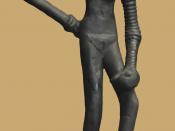Farming
The single, decisive factor that made it possible for mankind to settle in permanent communities was agriculture.
In both civilizations, farming was carried out. During the Indus Civilization, wheat, barley, rice, a number of vegetables, and dates were some of the common crops. The crops produced might have been similar over the two civilizations as both their diets were alike. They also farmed sheep, pigs and cows. Since rainfall was not consistent, they were reliant on the river water.
Yoga
Yoga originated from the Indus Civilization. The Aryans probably did not know yoga in the earlier phases, but later it did penetrate into their society, maybe taken from surviving traditions among the common people. The science of yoga has greatly influenced the thought process and lifestyle of the people of India and the neighbouring countries in South Asia.
In a single, four thousand-year old terra cotta seal, found among hundreds of others, there was an artistic portrayal of a man, or god, meditating in a yoga posture.
This could indicate that yoga was already a well-established part of life of this ancient civilization, but it could also mean that the priests of that culture simply sat cross legged to pray.
Design of Bullock Cart
From every crop that a farmer grew, a large portion of it had to be paid into public granaries. At the Mohenjo-daro site, there was a high loading platform above a lower spot intended for carts where the farmers would dump their grain. It is assumed that this cart was small and powered by an ox, similar to those used in the area today. It was also used as a means of transport.
Terracotta models of bull driven carts have been excavated from the Mohenjo-daro site, and it appears that these carts have...


